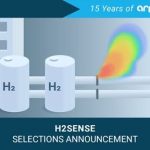-
US Department of Energy announces $18m to advance research in hydrogen detection systems
Date posted:
-
-
-
Post Author
Greg Kelsall
-
-

The US Department of Energy’s Advanced Research Projects Agency-Energy (ARPA-E) has announced $18 million for nine projects to accelerate research that supports the detection and quantification of hydrogen emissions throughout the supply chain.
Hydrogen detection methods today are primarily focused on leaks that could pose a fire hazard, typically at volumes of parts per million. Significantly lower concentration leaks may have a climate impact without posing an immediate safety hazard. ARPA-E’s H2SENSE projects will work to create a new generation of sensors to detect and quantify concentrations of hydrogen in the range of parts per billion.
The selected projects are show below, with the aim of developing fully integrated systems that incorporate:
- Sensors
- Data transmission
- Dispersion and quantification analyses
- Peripheral components and modelling necessary for operation
- Calibration
- Accurate quantification of hydrogen.
GE Vernova Advanced Research Center -LOCATE: H2 Leak LOCAlization and QuanTification Using Physics-Enhanced Analytics and Fence-Line Monitoring – $2,700,000
Implement a high-fidelity and cost-effective gas sensing technology based on dielectric excitation of sensing materials and couple it with physics enhanced analytics to detect and identify hydrogen leaks at industrial sites. The localisation capability will differentiate and rank multiple leaks with a spatial resolution within 10 metres of actual leak locations. The cost-effective and simple deployment of hydrogen leak monitors with their 5-10 parts per billion detection sensitivity will support the evaluation of hydrogen sites over diverse geographic locations and climate conditions.
Colorado State University – Hydrogen Emissions Monitoring System Based on Trace Gas PARS Sensor – $1,954,931
Develop and validate a hydrogen point sensor based on photoacoustic stimulated Raman spectroscopy for trace detection of hydrogen in the atmosphere with a lower limit of detection of 1 part per million in 5 seconds. The analytics method will be tailored to the complexity of a given site, with an inverse modelling approach for simple sites and a tracer co-release method for more complex sites.
National Energy Technology Laboratory –PA Novel Fiber Optic Sensor Systems and AI-Driven Methods for Hydrogen Pipeline Emission Quantification – $1,700,000
Develop and field validate novel distributed fibre optic sensors installed on the pipeline and an AI-driven pipeline-specific quantification method called H2-SMART to locate and quantify hydrogen emissions from hydrogen pipelines accurately and efficiently. The novel fibre optic-based sensors are selective for hydrogen and offer km-scale distance coverage for large-area emissions monitoring.
University of Wisconsin-Madison –Large-Survey-Area H2 Leak Detector based on a Quadcopter-Mounted Laser Imager – $2,491,594
Develop a precise hydrogen sensor and a novel laser-based system to image and record videos of hydrogen leaks. The laser-based system uses an inverse backscatter absorption gas imaging (iBAGI) technique to quantitatively image hydrogen plumes with megapixel spatial detail. The iBAGI system can be mounted on a quadcopter to facilitate large-area emissions monitoring. Computer algorithms, data science, and computational fluid dynamics will be used on the videos to estimate leak rates.
Serinus Labs –Parts Per Billion Hydrogen Plume Emissions Reporting System (ppb-HyPERS) – $2,540,659
Combine ultra-sensitive proprietary hydrogen sensors with ultra-reliable low power radios to produce wireless hydrogen sensor nodes, collectively forming a wireless ‘mesh’ network over outdoor areas. Sensor data will be combined with weather data and parsed using RTX Technology Research Center’s artificial intelligence framework that can accurately identify and quantify hydrogen leaks.
Northeastern University –Wireless Hydrogen Integrated Sensing via PiezoElectric Resonators and Switches (WHISPERS) – $2,430,000
Develop a platform to integrate advanced miniaturised and near-zero power hydrogen sensing technology with sophisticated airflow modelling. The sensing nodes generate a detailed geographic heatmap of hydrogen concentrations and flow within the monitored area. The nodes can last for years on a small battery because they employ a zero-power electromechanical switch that activates the sensing module only when detecting elevated hydrogen levels.
Princeton University –HydroNet: Integrated Photonic System for Hydrogen Leak Localisation, Quantification and Monitoring – $1,700,000
Develop hydrogen sensing capabilities based on novel spectroscopic advances with high selectivity and sensitivity. A dynamic sensor packaged on a drone will provide rapid leak quantification and localisation to support the growth of the emerging hydrogen economy.
Aerodyne Research – Billerica, MA Autonomous Method to Quantify and Localise Hydrogen Facility Emissions – $1,880,484
Aerodyne Research will develop an innovative sensor system to locate and quantify hydrogen emissions. Tracer gases will be released, and machine learning software will control the sampling and tracer gases to produce live emissions results. By identifying hydrogen leaks, this technology will support the burgeoning hydrogen energy industry.
2Witech Solutions –Hybridised High-Q Plasmonic Hydrogen Sensor – $1,000,000
Develop the first mobile 20 parts per billion-level self-cleaning plasmonic hydrogen sensor system, which will improve sensitivity compared with state-of-the-art sensors by one order of magnitude. The system will use a plasmonic meta-surface, a surface coating with excellent hydrogen permeation, for trace detection against varied environmental backgrounds.
